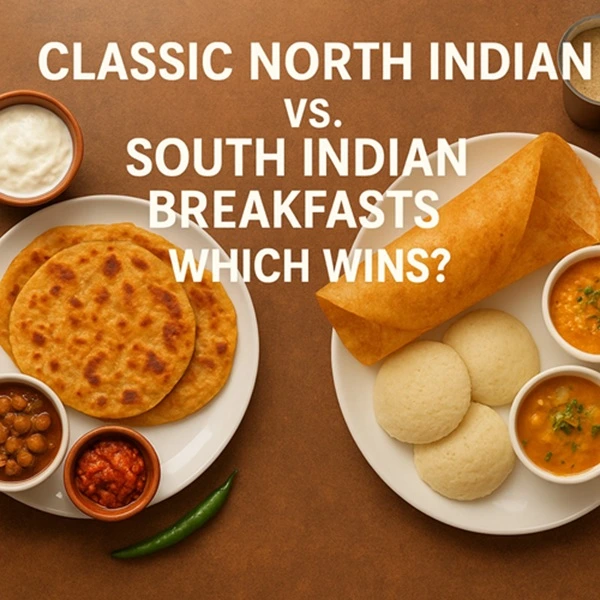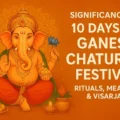Breakfast is not just the first meal of the day, it’s an emotion. In India, breakfast changes every few hundred kilometers, telling stories of culture, climate, tradition, and taste buds.
Being born and brought up in North India, my mornings were filled with hot parathas, chole bhature, and steaming cups of chai. But after spending over a decade in South India, I have fallen equally in love with fluffy idlis, crispy dosas, and the aroma of filter coffee.
This article is not just a comparison, it’s a celebration of two breakfast worlds that define India: North Indian vs. South Indian breakfasts. Let’s dive in, dish by dish, and find out which one really wins.

North Indian Breakfasts – Hearty, Rich & Comforting
North Indian breakfasts are all about generosity—generous fillings, generous oil or ghee, and generous flavors. The cold mornings in Delhi, Punjab, and Uttar Pradesh almost demand a hearty breakfast that keeps you full till lunch.
Popular North Indian Breakfast Options:
- Parathas – Stuffed with aloo, paneer, gobi, or even mooli, served with curd, butter, or pickles.
- Chole Bhature – Delhi and Punjab’s pride; fluffy bhature paired with spicy chole.
- Poori Aloo – Light, puffed pooris with potato curry; a Sunday ritual in many households.
- Kachori Sabzi – Especially famous in Rajasthan and UP; spicy, tangy, and indulgent.
- Bedmi Puri – A Delhi winter special; puri stuffed with lentils, served with aloo sabzi.
- Paneer Bhurji with Toast or Paratha – Protein-packed and loved by all.
- Bread Pakora – A popular street breakfast; bread stuffed with potato and dipped in besan batter.
- Rajma Chawal for Breakfast (in some homes) – Though technically lunch, many households relish leftovers for breakfast.
- Halwa-Poori – Especially in festivals or special days; rich and sweet start to the day.
- Chai + Biscuit Combo – Let’s admit, no North Indian breakfast is complete without cutting chai.
Character of North Indian Breakfasts: Hearty, oily at times, spicy, and satisfying. They’re heavy enough to fuel you through long mornings.
South Indian Breakfasts – Light, Balanced & Flavorful
Moving to South India, I realized breakfast here is an entirely different philosophy—light yet filling, spiced yet subtle, and always balanced. Most dishes are rice or lentil-based, making them easy to digest and ideal for hot climates.
Popular South Indian Breakfast Options:
- Idli – Soft, fluffy rice-lentil cakes, served with chutneys and sambar.
- Dosa – Crisp and golden; comes in varieties like masala dosa, rava dosa, neer dosa, and set dosa.
- Medu Vada – Donut-shaped fritters made with urad dal, crunchy outside, soft inside.
- Upma – Made with semolina or millets; light, healthy, and customizable.
- Pongal – Rice and moong dal cooked with ghee, pepper, and cashews; comfort in a bowl.
- Appam with Stew – Kerala’s breakfast gem; soft hoppers with vegetable or chicken stew.
- Puttu with Kadala Curry – Cylindrical steamed rice cakes with black chickpeas curry.
- Adai with Avial – Protein-packed lentil pancake with coconut-based curry.
- Rava Kesari / Kesari Bath – Sweet counterpart of upma; semolina cooked with ghee and sugar.
- Filter Coffee – Strong, aromatic, and foamy—the heartbeat of a South Indian morning.
Character of South Indian Breakfasts: Steamed, fermented, lightly spiced, and nutritious. Ideal for daily consumption and keeps digestion smooth.
Comparing North Indian vs. South Indian breakfasts – Bite by Bite
| Aspect | North Indian Breakfast | South Indian Breakfast |
|---|---|---|
| Cooking Style | Fried, sauteed, and cooked with ghee/oil | Mostly steamed, fermented, and light |
| Base Ingredients | Wheat, chickpeas, paneer, potatoes | Rice, lentils, semolina, coconut |
| Flavors | Spicy, tangy, rich | Mild, subtly spiced, coconut-infused |
| Digestibility | Heavy, keeps full for long | Easy to digest, light on stomach |
| Pairings | Chutneys, pickles, butter, curd | Chutneys, sambar, podis, coconut oil |
| Beverage | Masala Chai rules | Filter Coffee reigns supreme |
| Best For | Cold mornings, long days, indulgence | Hot climates, daily meals, health focus |
Personal Take on North Indian vs. South Indian breakfasts – A Foodie’s Dilemma
Honestly, choosing between the two is like choosing between chai and coffee—both are unbeatable in their own ways.
- On a chilly winter morning in Delhi, aloo paratha with butter and chai feels like heaven.
- On a breezy Chennai morning, nothing beats crispy masala dosa with filter coffee.
If I crave comfort and indulgence, North Indian breakfasts win. But for everyday health, South Indian breakfasts take the crown.
So my verdict?
North Indian breakfasts are “festive meals,” while South Indian breakfasts are “everyday rituals.”
Health Perspective
- North Indian breakfasts are higher in fats and carbs due to frying and wheat-based dishes.
- South Indian breakfasts are lighter, fermented, and probiotic-friendly (idli, dosa).
- Balanced approach: Mixing both styles in weekly diets gives the best of taste and health.
North Indian vs. South Indian breakfasts : FAQs
1. Which is healthier—North or South Indian breakfast?
South Indian breakfasts are generally lighter and healthier due to steaming and fermentation, but North Indian parathas with curd also provide good nutrition when cooked with less oil.
2. Why do North Indians prefer parathas and pooris?
Because of colder climates, heavy wheat-based dishes keep the body warm and provide sustained energy.
3. Is dosa or idli good for weight loss?
Yes, both are light, low in fat, and protein-rich (when paired with sambar or chutney), making them great for weight management.
4. Can South Indian breakfasts be oily too?
Yes, certain dishes like vada or ghee pongal can be heavy, but most options are still lighter than fried North Indian breakfasts.
5. Which is more popular internationally?
South Indian breakfasts like dosa and idli are globally recognized due to their lightness and vegan-friendly ingredients, though parathas and chole bhature also enjoy fame abroad.
Conclusion
Both North and South Indian breakfasts are culinary treasures. North India brings in richness, indulgence, and festive charm, while South India offers balance, health, and everyday comfort.
As someone who has enjoyed both worlds, I can only say this:
If you want to indulge, go North. If you want to sustain, go South. But if you truly want to live, enjoy both!

Hi, I’m Prashant Jain — a curious soul, storyteller, and content creator at heart.I’ve always been drawn to the world of entertainment, travel, sports, health & lifestyle — not just as a writer, but as someone who genuinely lives these experiences. Whether I’m binge-watching the latest OTT series, exploring offbeat spiritual destinations in India, or diving deep into wellness routines and cricket match insights, I love sharing what I discover with like-minded readers.
PopNewsBlend is my way of blending personal journeys with meaningful stories — ones that inform, inspire, and keep you ahead of the curve. Everything I write comes from real observations, hands-on experiences, and a deep passion for understanding the world around us.
Discover more from Popnewsblend
Subscribe to get the latest posts sent to your email.







